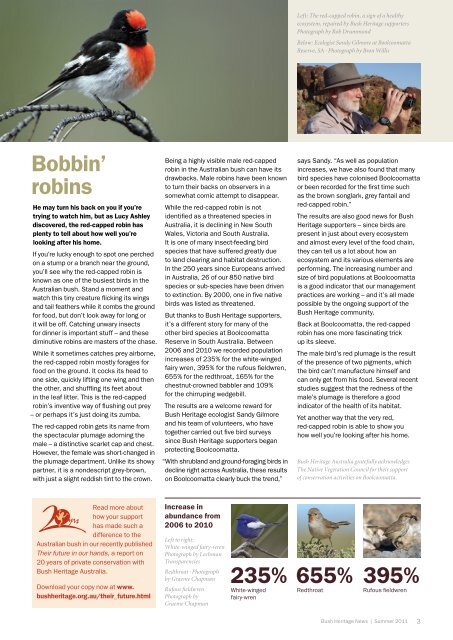BUSH HERITAGE NEWS - Bush Heritage Australia
BUSH HERITAGE NEWS - Bush Heritage Australia
BUSH HERITAGE NEWS - Bush Heritage Australia
You also want an ePaper? Increase the reach of your titles
YUMPU automatically turns print PDFs into web optimized ePapers that Google loves.
Bobbin’<br />
robins<br />
He may turn his back on you if you’re<br />
trying to watch him, but as Lucy Ashley<br />
discovered, the red-capped robin has<br />
plenty to tell about how well you’re<br />
looking after his home.<br />
If you’re lucky enough to spot one perched<br />
on a stump or a branch near the ground,<br />
you’ll see why the red-capped robin is<br />
known as one of the busiest birds in the<br />
<strong>Australia</strong>n bush. Stand a moment and<br />
watch this tiny creature flicking its wings<br />
and tail feathers while it combs the ground<br />
for food, but don’t look away for long or<br />
it will be off. Catching unwary insects<br />
for dinner is important stuff – and these<br />
diminutive robins are masters of the chase.<br />
While it sometimes catches prey airborne,<br />
the red-capped robin mostly forages for<br />
food on the ground. It cocks its head to<br />
one side, quickly lifting one wing and then<br />
the other, and shuffling its feet about<br />
in the leaf litter. This is the red-capped<br />
robin’s inventive way of flushing out prey<br />
– or perhaps it’s just doing its zumba.<br />
The red-capped robin gets its name from<br />
the spectacular plumage adorning the<br />
male – a distinctive scarlet cap and chest.<br />
However, the female was short-changed in<br />
the plumage department. Unlike its showy<br />
partner, it is a nondescript grey-brown,<br />
with just a slight reddish tint to the crown.<br />
Read more about<br />
how your support<br />
has made such a<br />
difference to the<br />
<strong>Australia</strong>n bush in our recently published<br />
Their future in our hands, a report on<br />
20 years of private conservation with<br />
<strong>Bush</strong> <strong>Heritage</strong> <strong>Australia</strong>.<br />
Download your copy now at www.<br />
bushheritage.org.au/their_future.html<br />
Being a highly visible male red-capped<br />
robin in the <strong>Australia</strong>n bush can have its<br />
drawbacks. Male robins have been known<br />
to turn their backs on observers in a<br />
somewhat comic attempt to disappear.<br />
While the red-capped robin is not<br />
identified as a threatened species in<br />
<strong>Australia</strong>, it is declining in New South<br />
Wales, Victoria and South <strong>Australia</strong>.<br />
It is one of many insect-feeding bird<br />
species that have suffered greatly due<br />
to land clearing and habitat destruction.<br />
In the 250 years since Europeans arrived<br />
in <strong>Australia</strong>, 26 of our 850 native bird<br />
species or sub-species have been driven<br />
to extinction. By 2000, one in five native<br />
birds was listed as threatened.<br />
But thanks to <strong>Bush</strong> <strong>Heritage</strong> supporters,<br />
it’s a different story for many of the<br />
other bird species at Boolcoomatta<br />
Reserve in South <strong>Australia</strong>. Between<br />
2006 and 2010 we recorded population<br />
increases of 235% for the white-winged<br />
fairy wren, 395% for the rufous fieldwren,<br />
655% for the redthroat, 165% for the<br />
chestnut-crowned babbler and 109%<br />
for the chirruping wedgebill.<br />
The results are a welcome reward for<br />
<strong>Bush</strong> <strong>Heritage</strong> ecologist Sandy Gilmore<br />
and his team of volunteers, who have<br />
together carried out five bird surveys<br />
since <strong>Bush</strong> <strong>Heritage</strong> supporters began<br />
protecting Boolcoomatta.<br />
“With shrubland and ground-foraging birds in<br />
decline right across <strong>Australia</strong>, these results<br />
on Boolcoomatta clearly buck the trend,”<br />
Increase in<br />
abundance from<br />
2006 to 2010<br />
Left to right:<br />
White-winged fairy-wren<br />
Photograph by Lochman<br />
Transparencies<br />
Redthroat · Photograph<br />
by Graeme Chapman<br />
Rufous fieldwren<br />
Photograph by<br />
Graeme Chapman<br />
Left: The red-capped robin, a sign of a healthy<br />
ecosystem, repaired by <strong>Bush</strong> <strong>Heritage</strong> supporters<br />
Photograph by Rob Drummond<br />
Below: Ecologist Sandy Gilmore at Boolcoomatta<br />
Reserve, SA · Photograph by Bron Willis<br />
says Sandy. “As well as population<br />
increases, we have also found that many<br />
bird species have colonised Boolcoomatta<br />
or been recorded for the first time such<br />
as the brown songlark, grey fantail and<br />
red-capped robin.”<br />
The results are also good news for <strong>Bush</strong><br />
<strong>Heritage</strong> supporters – since birds are<br />
present in just about every ecosystem<br />
and almost every level of the food chain,<br />
they can tell us a lot about how an<br />
ecosystem and its various elements are<br />
performing. The increasing number and<br />
size of bird populations at Boolcoomatta<br />
is a good indicator that our management<br />
practices are working – and it’s all made<br />
possible by the ongoing support of the<br />
<strong>Bush</strong> <strong>Heritage</strong> community.<br />
Back at Boolcoomatta, the red-capped<br />
robin has one more fascinating trick<br />
up its sleeve.<br />
The male bird’s red plumage is the result<br />
of the presence of two pigments, which<br />
the bird can’t manufacture himself and<br />
can only get from his food. Several recent<br />
studies suggest that the redness of the<br />
male’s plumage is therefore a good<br />
indicator of the health of its habitat.<br />
Yet another way that the very red,<br />
red-capped robin is able to show you<br />
how well you’re looking after his home.<br />
<strong>Bush</strong> <strong>Heritage</strong> <strong>Australia</strong> gratefully acknowledges<br />
The Native Vegetation Council for their support<br />
of conservation activities on Boolcoomatta.<br />
235% 655% 395%<br />
White-winged<br />
fairy-wren<br />
Redthroat Rufous fieldwren<br />
<strong>Bush</strong> <strong>Heritage</strong> News | Summer 2011<br />
3


